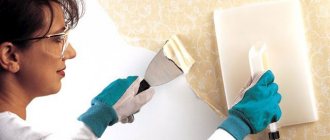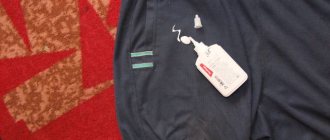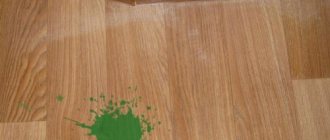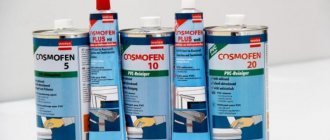Polyurethane foam is a widely used building material, the frequent use of which is due to its adhesive properties.
It is recommended to work with polyurethane foam only with gloves, but not everyone follows clear instructions, as a result of ignoring which it becomes possible to find out how corrosive the material used is.
Today we will try to figure out how and how to wash foam from your hands.
How to remove polyurethane foam from your hands: pros and cons of different methods
If you need to clean fresh suds from your hands, it's easy to do with wet wipes. Dry the surface thoroughly, then wash your hands with soap. If irritation begins after contact with the sealant, be sure to soften your hands with cream. Do not try to rub the foam, as this will increase the area where your hands are affected.
It is necessary to remove polyurethane foam one by one using the means depending on their aggressive effect, in order to prevent burns and severe irritation. Let's consider the most popular means and the principle of their effect:
- Vegetable oil or vinegar. Heated vegetable oil will not harm the skin. The disadvantage of this method is that you need to wait a certain time for the remaining sealant to completely disappear from the skin. For the procedure, you need to heat the oil and moisten the tampon with it. Then apply it to the contaminated area and wait about half an hour. After this, wash your hands thoroughly with soap.
- Salt is a good option for removing sealant from a small area of dirt. Table salt will soften hardened polyurethane foam and help get rid of it. Rub your hands well with salt, leave for a few minutes and rinse with water.
- Acetone or gasoline. These are already harsh chemicals that can lead to peeling skin and other side effects. First, test your nail polish remover. If you can’t use it to wipe off the dried sealant, then switch to gasoline. The smell is unpleasant, but the effect is more noticeable. After any of these procedures, be sure to lubricate the skin with a rich cream to prevent severe peeling.
- Dimexide. The gel is sold at the pharmacy. It is rational to use it in cases where the sealant has affected small areas of the skin of the hands. The gel acts by penetrating the pores, softening the foam. Exposure to the skin may lead to adverse reactions, so monitor the condition of the skin.
Dried polyurethane foam is more difficult to remove. If it sticks well to your hands, you won’t be able to simply wash it off with water. In this case, it will be necessary to remove it mechanically. To avoid damaging the skin, first you need to soften it with a rich cream. Since you will have to use a pumice stone or a stiff brush for cleaning, you must first moisten and apply a soap solution. Do everything carefully to avoid damage to the skin.
After such manipulations, it is recommended to treat your hands with a medicinal cream based on soothing, healing components (for example, chamomile or calendula). If you have not been able to completely get rid of the foam and there are residues on your hands, you should not try to clean it. Over time, it will disappear on its own when exposed to soap solutions when washing your hands.
Special means for washing polyurethane foam
In order to quickly and effectively get rid of sealant on your hands, you need to remove it as soon as it gets on your skin. To do this, remove it with a damp cloth, moving from the edges of the stain to the center, and then wash your hands thoroughly with soap. You should act as quickly as possible, because when the foam begins to dry out, it will be much more difficult to deal with it.
Acetone
Acetone or nail polish remover can help remove foam from your hands. The application algorithm is as follows:
- Soak a cotton pad in your chosen product.
- Carefully wipe the area of contamination until all traces of sealant are removed. Work in a well-ventilated area, as acetone has a strong and extremely unpleasant odor.
- Wash your hands with soap.
- Apply moisturizing or nourishing cream.
Acetone or nail polish remover will help you quickly and effectively remove sealant from the skin.
Kerosene
You can wash off the foam from your hands using kerosene. To do this, soak a soft cloth in the product and wipe the stained area. After handling, wash your hands well with soap and apply a rich cream. You can use White Spirit in a similar way.
Special product
A special solvent will help remove the sealant, which must be purchased in advance in case of a mistake. In addition to cleaning your hands, the aerosol will help get rid of stains on clothes, floors, furniture, guns and other materials. If possible, choose a solvent from the same company as the sealant in order to get maximum effect.
Procedure for using the aerosol:
- Please read the instructions and safety precautions carefully.
- Shake the can and spray the mixture onto contaminated skin.
- Rinse off the solvent and sealant under running water, and then wash your hands well with soap and water.
A special solvent is effective against fresh sealant, but if the foam has already hardened, it is powerless
How can you remove polyurethane foam from skin?
Since it is important for us not only to remove dirt from the skin, but also not to harm the cover, it is important to carefully select products for cleaning foam from hands. Experts identify the following products that will not help in removing foam and can be dangerous:
- chemical aggressive acids and vinegars. They are not able to split the sealant, but can leave burns. Eliminate this option for cleansing the skin of your hands so as not to encounter harmful consequences;
- chlorine-based compounds. Such substances have a negative effect on the mucous membrane. They are prohibited for contact with skin;
- alkaline compounds. Such substances are not intended for removing polyurethane foam. Alkali may cause burns to the skin.
It is best to try steaming your hands in a steam bath with the addition of baking soda. This option is worth trying if you were unable to remove the sealant using a saline solution. Soak for about half an hour in the soda solution to achieve the desired result.
Home remedies for removing sealant
In the absence of a special aerosol or solvent, improvised means will help you wash foam from your hands at home. Their main advantages are availability, safety and ease of use. However, they do not always have an immediate result, and it will take a lot of effort to completely remove the sealant.
Salt
The simplest and most effective home remedy is table salt. Application procedure:
- Wet the stained area with warm water.
- Wash your hands with salt. Gently massage the stained area to remove any remaining sealant.
- Wash your hands with soap and then moisturize with cream.
Table salt or sea salt will help remove sealant from your hands; it acts as a scrub and cleanses the skin.
Vegetable oil
To clean significant dirt or remove hardened sealant, use vegetable oil. Instructions for use:
- Heat the vegetable oil to a comfortable temperature.
- Dampen a cotton pad and spread the product over the stain. To remove large stains, apply an oil-soaked cloth and leave for half an hour.
- Wash your hands under running water and soap.
Laundry soap
Laundry soap will help get rid of minor stains:
- Prepare a bath of warm water and soak your hands in it for 10 minutes.
- Rub moistened and steamed skin well with laundry soap.
- Scrub the stained area with a brush or pumice stone.
- Wash your hands well under running water.
Laundry soap is an effective means for removing foam from the skin of the hands.
Mechanical cleaning
A mechanical method will help remove the frozen composition. For the procedure, prepare a pumice stone, a stiff brush or sponge, soap and vegetable oil. Cleansing algorithm:
- Steam your hands in hot water for 10 minutes.
- Apply a rich cream or heated vegetable oil to the stain and leave for 25-30 minutes.
- Lather a pumice stone or brush and rub your hands well with it. Proceed carefully so as not to damage the skin.
- Repeat the procedure until the sealant is completely washed off.
After removing the foam, apply cream to your hands to moisturize and nourish the skin.
How to clean polyurethane foam from other surfaces?
It is almost impossible to seal perfectly, so you must know how to remove sealant from different types of surfaces:
- Cloth. The best method is mechanical removal after placing the textiles in the freezer. After this, you can try to remove the foam with a stationery knife. Any solvents can damage clothing.
- Varnished coatings. Aggressive chemical compounds can damage the varnish, so you should try to remove dirt mechanically or using wet wipes if the substance still clings.
- Doors. You can use special solvents. Another option is Dimexide gel. Glass surfaces are cleaned with vegetable oil.
- Plastic windows. White spirit, oil or Dimexide gel will do. Windows can be cleaned with acetone or vinegar.
- Floor coverings. Linoleum can be wiped with acetone or white spirit, laminate with vegetable oil.
How to get rid of liquid foam on your hands?
If you get polyurethane foam on your hands while using a building material, you need to act without delay. Only with a timely response will you be able to get rid of building material without much effort, and for these purposes you can use:
- Use a clean napkin or rag, avoiding spreading the foam onto nearby skin areas.
- Special washes and solutions designed to remove polyurethane foam, which are recommended to be purchased in tandem with this building material.
- Regular acetone. Nail polish remover containing this component is also suitable. After using the substance, the treated area of skin should be thoroughly rinsed under warm running water.
- Vegetable oil, preheated in a water bath.
- Kerosene.
- The drug is Dimexide, the use of which, despite its effectiveness, is not recommended in large quantities due to its high toxicity to the human body.
- Use rock salt, a handful of which should be gently rubbed onto the skin with any remaining foam.
- A body scrub, before using which it is recommended to steam your hands in warm water.
- The method of steaming the skin. To do this, it is recommended to immerse your hands in a container of hot water for 10 minutes, after which all that remains is to get rid of the softened building material on the skin. As practice shows, to enhance the effect, ordinary table salt is perfect, which can be added to the bath at the rate of 1 tbsp. spoons of substance per 1 liter of liquid.
The use of most of the listed products can lead to severe drying of the skin on the hands. Therefore, after the procedure, it is strongly recommended to treat your hands with a nourishing cream.
Where else does it often end up and how to wash it off?
Before working with polyurethane foam, protect all nearby surfaces by covering them with disposable material. Repairs must be carried out in special clothing, which you don’t mind throwing away, since it is difficult to remove dried clots from the fabric. But despite the measures taken, the material may accidentally end up on various surfaces. How to remove splashes from soiled objects and things?
See also
How to quickly starch a hat with your own hands at home
From clothes
To remove traces of polyurethane foam, there are several methods:
- Mechanical method. Cool the damaged tissue by placing it in the freezer or placing an ice cube on the stain. The hardened and brittle substance is scraped off with a knife or needle.
- Cleaners. Wash to remove polyurethane foam is applied directly to the dirt with a cotton swab.
- Disguise. The damaged area is covered with applique or embroidery. In this way, not only does the trace of pollution disappear, but also the wardrobe is updated.
Varnished surface
If the object is varnished, it is best to remove the mounting foam from it at the moment when it has stopped sticking to your fingers, but has not yet hardened. This stage is called the formation of the rubber substance. The substance is carefully picked up by the edge and completely removed from the surface, after which the base is treated with napkins to remove the greasy mark.
If the sealant has dried, it is scraped off with a spatula, and the scratches left by the tool are varnished. Solvent can damage the varnish, so chemical treatment is not recommended.
From the doors
The method of removing polyurethane foam from doors depends on the material from which they are made:
- If the door is metal, the sealant can be removed mechanically: cut off with a knife or blade, and the remaining residue can be removed using a stiff brush. The chemical method is also suitable for metal doors. Apply any of the solvents (Macroflex, Cosmofen, Dimexide) to the contaminated area for 15 minutes and then wipe off with napkins.
- Plastic doors are cleaned with Cosmofen 10. The remover can handle fresh and hardened clots. The surface is treated with a napkin with the product applied to it until the stain disappears.
- Wooden door leaves can be cleaned well with Dimexide, which must be tested in advance in an inconspicuous area. The excess is cut off, the product is applied for 10 minutes, after which the cleaner is washed off along with the remaining stain.
- Eco-veneer is a capricious material, the structure of which can be damaged by aggressive solvents. The polyurethane foam is cut off with a knife, the area is wiped with a damp sponge and treated with soda. You can try to remove contamination using white spirit, be sure to test it in advance in an inconspicuous area. Apply the product for half a minute, then clean the surface with a dry cloth.
- Glass doors can be cleaned with vegetable oil. But if it gets on the wood, it will lead to unsightly greasy stains that cannot be removed.
See also
15 recipes for quickly making toothpaste slime at home
From plastic windows
Construction foam used when installing plastic windows often ends up on the plastic profile and glass. You can wipe away its traces using professional cleaners that are effective and safe, or you can turn to improvised means.
White spirit, vegetable oil or Dimexide will help remove clots from the plastic profile. Glass can be cleaned with many means, for example, vinegar, acetone, kerosene.
Floor cleaning
If polyurethane foam accidentally falls on the floor, you must carefully choose a cleaner so as not to harm the coating. Depending on the type of flooring, different cleaning techniques may be more effective and safer.
Linoleum
To clean smooth linoleum that does not have a textured pattern, the sealant is allowed to dry and then peeled off. For floor coverings with ornaments, you can use white spirit, acetone or plain water. Water lasts a long time; the stain needs to soak for about 12 hours, and this method is suitable if there is no risk of seepage under the coating.
Laminate
The safest product for laminate flooring is vegetable oil. An aggressive solvent can damage the coating, and prolonged exposure to water will cause the laminate to swell.
Features of the composition and use of polyurethane foam
The basis of polyurethane foam, widely used in repair work and construction, is polymers (polyol, isocyanates), propellant gas, stabilizers, and catalysts. It is used for the following purposes:
- Sealing - filling cracks in roofing materials, around window and door openings.
- Soundproofing - filling voids between walls.
- Gluing (fixing) door and window blocks, attaching insulating materials (for example, foam blocks).
At different times of the year, a suitable type of polyurethane foam is used: summer, winter, all-season. Depending on the composition and manufacturing technology, this substance hardens within 15–20 minutes.
When working, avoid getting foam on exposed skin.
At the slightest contact with the face, skin of the hands or hair, the foam must be removed quickly.
Some useful tips
As a rule, using the methods discussed above will be sufficient to eliminate polyurethane foam that gets on your hands. If for some reason it was not possible to get rid of the building materials, there is still no reason to worry.
As practice shows, over several days the dried foam gradually peels off from the skin, which is associated with cell regeneration processes.
If polyurethane foam gets on your hands, you should not use the first available product to remove it, despite its cleaning properties. Thus, it is strictly not recommended to wipe your hands with acetic acid, Domestos and similar substances. It has long been noted that such compositions do not contribute to the dissolution and removal of stable building materials, but can cause serious burns to the skin.
After treatment, hands must be lubricated with cream, giving preference to compositions that have a regenerating and antiseptic effect. Preparations containing aloe juice and ginseng will be quite nutritious and useful.
In order to avoid unpleasant consequences of using foam, its use must be approached responsibly, taking into account all precautions.
You should work with building material only with gloves and goggles, using unnecessary clothing, because it is almost impossible to clean the fabric from the polyurethane foam. The use of a headgear is also mandatory, because you can only get rid of foam on your head by removing it along with your hair.
How to remove foam from linoleum
If the linoleum has a smooth surface, the sealant will be much easier to clean off. Scrape it off using a putty knife and other handy tools. Do this manipulation carefully so as not to cut the surface of the coating.
With linoleum that is corrugated and has an embossed pattern, dried foam will be more difficult to remove. Apply acetone to the surface and scrape with a chisel.
There are specialized products for removing stains from polyurethane foam. Some are designed to remove fresh stains, others for dried ones. When choosing cleaning products, it is advisable to choose a manufacturer of the same brand as the foam itself.
How to wash your hands from fuel oil
Modern people are surrounded by a wide variety of mechanical devices. Therefore, no one is immune from contamination by greasy lubricants. Men are especially often concerned about the issue of removing fuel oil from their skin, because they are most often associated with the maintenance of equipment. But women and children can also get dirty with fuel oil. To get rid of it, you will need special or improvised means. It can be:
specialized cleaning products for washing heavily soiled hands- dishwashing detergents;
- chemicals for dry hand cleaning;
- White Spirit;
- washing powder;
- butter;
- margarine;
- eucalyptus oil;
- laundry soap;
- ammonia;
- petrol;
- car shampoo;
- soda;
- coffee grounds;
- berries;
- clay.
Depending on possibilities or personal convictions, it is permissible to use both chemical and traditional methods to remove fuel oil. The choice determines the intensity of contamination and the characteristics of the victim’s body.
Chemical methods
Chemicals are most often used to remove fuel oil. The drugs are reliable and effective. Contamination is quickly removed with effective chemical reagents. There are several options for using household chemicals.
According to the first method, to remove fuel oil, use washing powder or dishwashing detergent:
- A little substance is applied to the skin and the dirt is gently rubbed.
- Residues are washed off with warm water.
After using the drug, it is recommended to lubricate cleansed skin with a nourishing cream to protect the dermis from drying out and irritation.
Using the following method, you can use special preparations to clean heavily soiled hands. You can buy a lot of cleaning products in stores to remove complex stains. Buying such a drug is within the capabilities of anyone.
The most popular were weakly acidic cleaners. They contain a high content of abrasives. An example of such products is the paste-like suspension SOLOPOL:
- Apply the substance to dry hands.
- In the contaminated area, the suspension is thoroughly ground.
- Add a little water and grind again.
- Residues and dirt are washed off with warm water.
- Hands are dried and lubricated with a nourishing, better regenerating, cream.
To clean your car from fuel oil contaminants, service stations sell special shampoos. Simply wash your hands with it to get rid of traces of dirt. The most effective products are Doctor Wax, Karcher, Sonax.
White spirit and other solvents are aggressive substances. But you can get into the top ten. In addition to white spirit, it is permissible to use gasoline, diesel fuel, and even motor oil. All substances act directly on the structure of the dirt.
The most delicate of all such products is motor oil. It cleans almost any dirt and is used without water. The composition has a disinfecting effect, which is especially good for damaged skin.
How to protect your hands and not get dirty?
Before working with construction foam, take precautions. Wear thick gloves and remove them after installation.
Even if you handle the cylinder or gun correctly, there is a risk of getting dirty with polyurethane foam. Contact with the skin of the hands can cause damage to epithelial cells. If trouble does occur, do not panic, because there are professional means and folk methods for cleaning polyurethane foam. Any method must be used carefully, following the instructions, so as not to cause even more harm to the skin.
We recommend reading: The drum in the washing machine has stopped spinning. Causes of failure.
Removing dried foam
In this situation, you can also do without radical measures.
- The dried substance cannot be removed with solvents alone; you will have to resort to mechanical action. You need to take pumice or sandpaper (preferably fine) and carefully scrub the stain.
- Sometimes vegetable oil helps. It should be warmed up a little and lubricated the contaminated area. After a few minutes, the remaining foam will soften and can be easily removed with your fingernails.
- Experts use their own method: hold their hands in a salt solution (5 minutes), and then rub them with a pumice stone.
- If the substance sticks to the nails, then take a bath with heated oil. If it doesn't help, a manicure file comes to the rescue.
In some cases, Dimexide is used, but it can cause skin burns. Therefore, the treated area is isolated with film. By the way, this drug can be used only after removing the other solvent.
If all efforts are not crowned with success, you should not worry; after some time, they will disappear on their own. The skin is constantly renewed and dead cells are gradually exfoliated.
Expert opinion
Mikhailov Ivan Maksimovich
Furniture maker. Work experience 3 years.
Typically, this process occurs within 7 days. To speed things up, you can take a hot bath. The foam will be removed faster if the skin is steamed. By the way, the foam is quickly destroyed by the sun's rays.
If such a situation is not allowed, then these tips will not be needed. While working, wear gloves on your hands, cover your hair with a hat, and wear thick clothing on your body. But you still need to have a special solvent on hand.
- Features of pollution
- What can you use to wipe it off?
- Cleaning methods at home
- Useful tips
Many home projects related to construction or renovation require the mandatory use of polyurethane foam. Without this composition, you cannot install either windows or doors, you cannot insulate your balcony, you cannot install pipes.
It is famous both for its adhesive properties and its ability to quickly dry out and eat into clothes, skin, and surfaces in the apartment.
How to clean your hair (head)
To remove foam from hair before it hardens:
- Start combing out the building compound as soon as you notice it. This will remove the main part. Do not use solvents. If they come into contact with the eyes, they cause a burn.
- You can use Dimexide to cleanse the remaining mounting solution from your hair. This medicine is sold in pharmacies and is used, among other things, to combat baldness.
- Tear the cotton wool into small pieces. Moisten with Dimexide and insert it between the teeth of a flat comb. Continue combing for 3–5 minutes, periodically moistening the cotton wool with the preparation. The medicine should soften the remaining foam.
- Rinse your hair with shampoo.
Dimexide is a medicine and has a number of side effects. Please read the contraindications carefully before use.
What special means should be used to remove polyurethane foam?
- Dimexide removes foam well from surfaces - this drug can be purchased at the pharmacy. Due to its composition, it destroys the structure of the foam.
- Acetone is effective for fresh stains. If the foam has already hardened, acetone will not help.
- White spirit - can be used to remove small residues of foam after the bulk has been removed with a knife.
Sometimes it makes sense to use special tools. They are produced differently for fresh foam and already frozen foam. You should also pay attention to what surfaces the product is intended for.
Here are some options:
- eco-cleaner for polyurethane foam from Tytan. Designed to remove uncured substances and glue. Has the form of an aerosol;
- Bau Master cleaner. Used to remove fresh splashes from surfaces, clothing and skin;
- Soudal cleaner. It is produced in the form of a paste with a gel-like consistency, complete with a brush for applying the product and a spatula for removing it. Easily destroys foam residues on non-porous surfaces;
- cleaner for hardened polyurethane foam Kudo Foam Remover. Effectively removes residues of one-component foam from surfaces made of metal and plastic. It can also be used to get rid of other products containing polyurethane: various sealants, paints and glue;
- Quilosa Orbafoam Remover. The product contains an aggressive mixture of solvents. Damage to painted and varnished surfaces may occur, so apply the cleaner carefully, avoiding contact with adjacent areas.
The use of polyurethane foam rarely goes without contaminating the floor, furniture, and personal belongings, so it makes sense to take care of purchasing cleaners in advance. They can be bought at any hardware store.
Any cleaner is a strong chemical, so work should only be done with gloves.
Do not spray them near an open fire, and do not violate the integrity - pierce or pierce already used cans. If the cleaner gets into your eyes, rinse them with plenty of running water and consult a doctor.
Features of pollution
A person who does not understand repair issues and who has taken sealant for work for the first time will most likely end up with it on his hands. Working with polyurethane foam without gloves and without getting dirty is very difficult
Even if a person has taken all precautions, there is a possibility that a couple of drops of sealant will end up on uncovered areas of the skin
Polyurethane foam is a type of sealant that contains polyurethane. It is produced in the form of an aerosol and is used in almost every type of construction and repair work. When frozen, this composition becomes solid polyurethane foam. The cylinder contains a mixture consisting of a liquid prepolymer and a propellant gas. Thanks to the presence of this gas in it, the foam comes out from there. Hardening occurs through interaction with moisture both on the surface and contained in the air of the room. Accordingly, the drier the air in the room, the longer the composition will harden. You can speed up this process by spraying the foam with water from a spray bottle.
Typically, solid foam is almost white, with a slight tint of yellow. However, if it is exposed to ultraviolet rays, it turns yellow and loses its connecting properties. The weight of the composition is very small. In addition, the mounting sealant is not moisture resistant. The adhesive properties are very high - the composition does not “work” on Teflon, polyethylene, silicone, polypropylene.
When working with polyurethane foam, it is necessary to take into account such properties as primary and secondary expansion. Primary is the expansion that occurs with the sealant immediately after it leaves the container. Secondary - until the composition completely hardens. It can vary from 15 to 100%. In the case where the percentage of secondary expansion is high, it is necessary to apply foam very sparingly to those places where there is a possibility of its strong swelling and, as a result, deformation of the surface.
Gaps and cracks are filled with polyurethane foam for heat, water and sound insulation. In addition, it is used to fasten pieces of building materials together. Previously, cement or tow was used for these purposes, but it took a lot of time and effort, and the quality of adhesion of the materials to each other sometimes left much to be desired.
Nowadays, when a large number of new, natural and artificial materials have appeared, a better, faster and easier to use means for fastening them together is required. To work with polyurethane foam, no preparation is required, and there is also no need to use additional devices and tools - just purchase a cylinder, study the instructions for using the material, and you can begin construction or repair work.
In order for the foam to harden correctly and not lose its properties, you need to follow the rules for working with it:
- The temperature should be in the range from +5 to +30 C.
- The coincidence of the primary and secondary expansion of the foam with the size of the hole to be sealed. If it is less than 1 cm, then it is better to use putty.
- Before starting work, the place where it will be done is sprayed with water - this will allow the foam to harden better.
- Shaking the container must be done for at least a minute so that all the contents turn into a homogeneous mass and mix well.
- After applying the foam, it must be sprayed with water again.
- If it seems that not enough has been applied, sealant should be added no earlier than half an hour later.
Of course, when working with this type of hermetic mixture, it is best to use thick rubber gloves and wear work clothes that you don’t mind getting dirty and thrown away in case of an unusual situation. But even then, there is a chance that drops of sealant will get on the skin. In this case, the foam blocks air access, which can cause serious allergic reactions. Therefore, you need to wash it quickly and painlessly, without damaging the skin.
Some experts recommend lubricating the skin with vegetable oil or Vaseline to prevent the sealant from sticking to your hands. However, this is not very convenient. In addition, after finishing work, washing off everything that was touched by oily palms is also problematic. Therefore, this advice is not widely used among those who have at least a little knowledge of repair and construction work.











